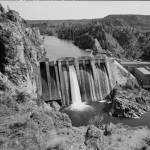Tectonic changes in the Late Cretaceous
90 million BCE • Earth
"By the beginning of the Cretaceous, the supercontinent Pangea was already rifting apart, and by the mid-Cretaceous, it had split into several smaller continents. This crested large-scale geographic isolation, causing a divergence in evolution of all land-based life for the two new land masses. The rifting apart also generated extensive new coastlines, and a corresponding increase in the available near-shore habitat. Additionally, seasons began to grow more pronounced as the global climate became cooler. Forests evolved to look similar to present day forests, with oaks, hickories, and magnolias becoming common in North America by the end of the Cretaceous."
University of California Museum of Paleontology, "Cretaceous: Tectonics and Paleoclimate."
Image: Carl Malamud, CC BY 2.0, via Wikimedia Commons


Learn about Maya Lin’s fifth and final memorial: a multi-platform science based artwork that presents an ecological history of our world - past, present, and future.

Discover ecological histories and stories of former abundance, loss, and recovery on the map of memory.

Learn how we can reduce our emissions and protect and restore species and habitats – around the world.

See how art can help us rethink the problems we face, and give us hope that each one of us can make a difference.

Help make a global memorial something personal and close to home. Share your stories of the natural world.


